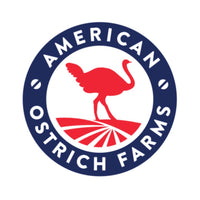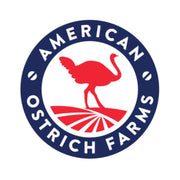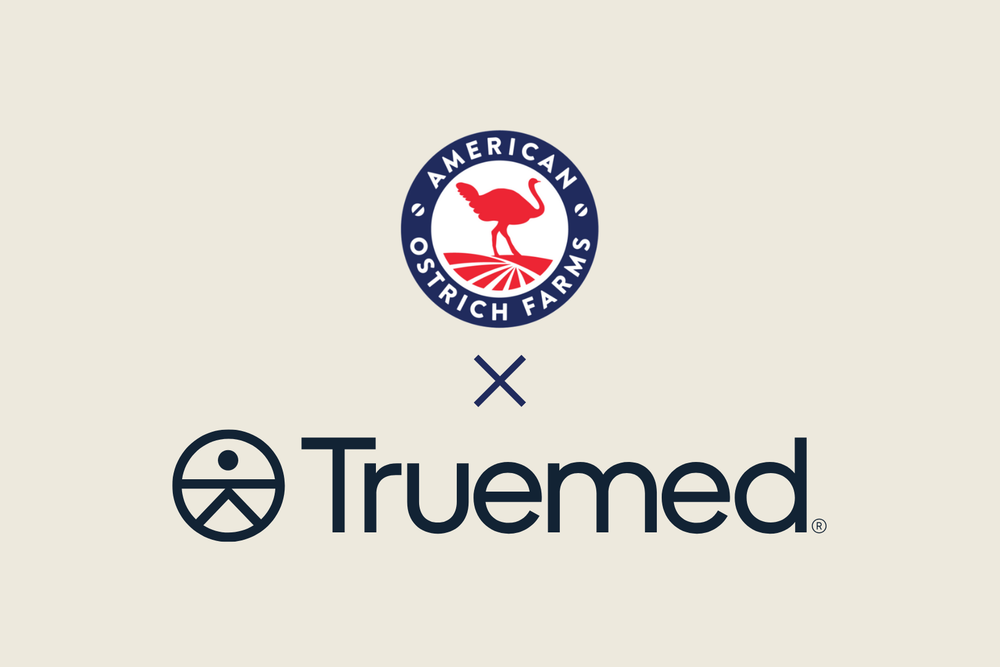Ever wondered what ostriches eat to grow so big, strong, and healthy?
Their diet is the foundation of what makes ostrich meat — and even ostrich oil and pet treats — so uniquely nutrient-rich and sustainable.
Let’s explore what fuels these incredible birds and why that matters for the products you bring home from American Ostrich Farms.
WILD OSTRICH DIET
Ostriches are omnivorous, meaning they consume a variety of plants and animals.
According to the University of Michigan Museum of Zoology, wild ostriches are generally found in dry, warm savannas and various other arid and semi-arid locations throughout Africa. The same article goes on to explain that these birds used to live throughout Asia and the Arabian Peninsula, but due to a number of factors, their populations have been reduced primarily to sub-Saharan Africa. The location of where they reside has a direct impact on their diet.
In the wild, ostriches have a diet made up primarily of plant matter. In the wild, ostrich diets consist of roughly 60% leafy plant material, 15% fruits or legumes, 5% insects or small-sized animals, and 20% grains, salts, and stones. They are fairly selective in their choices such as green grasses, wild leaves, shrubs, roots, berries, succulents and nuts.
Although small animals, bugs, and scavenging generally make up the smallest portion of an ostrich’s diet, it is still important to prevent starvation. In the wild, ostriches will consume mice, rats, snakes, lizards, grasshoppers, crickets and moths. This diversity ensures they receive fiber, protein, micronutrients, and energy — all critical for growth, egg production, and vitality.
Because they roam vast, open landscapes, their diet is naturally clean, nutrient-dense, and low in fat — just like the meat that results from it.
WHY DO OSTRICHES EAT ROCKS?
Ostriches, like many other birds, do not have teeth, so digestion is difficult. They swallow tiny pebbles and grit (called gastroliths, literally "stomach stones") and they hold them in a muscular part of their stomach called a gizzard. They do not digest the rocks; instead, they use them to help grind down the various foods they consume in order to make them more easily digested. Over time, the rocks will wear down until they eventually erode away completely. When this happens, the bird will replace them with more rocks to keep their digestion on track.
FARM-RAISED OSTRICH DIET
On every continent except Antarctica, ostriches are raised commercially for their meat, cosmetic-grade moisturizing oils, and various other byproducts such as pet foods, leather, feathers, and eggshells. Ostriches raised for commercial purposes are fed a variety of commercially available feeds, which vary significantly depending on what part of the world the farmed ostriches are raised. Thanks to their flexible eating habits, as long as their ration contains all the vitamins and minerals their bodies need to thrive during different stages of life, many different types of commercial diets can be appropriate.
Because ostrich farming is not nearly as widespread and does not have anywhere near the historical record as other farmed livestock, there is a dearth of information about what constitutes the most optimal commercial ration. Certain companies such as American Ostrich Farms, headquartered in Idaho, have invested heavily in developing the optimal balances based on the most up-to-date and rigorous science surrounding feeds for ratites — also known as flightless birds.
American Ostrich Farms has dedicated thousands of hours into feed analysis, including the nutritional composition and benefits of each feed component, as well as the specific needs for each stage in the ostrich’s life cycle. The blend of feed components we’ve developed over the last decade ensures a balanced, species-appropriate diet formulated for growth and health. Our birds enjoy a carefully balanced diet modeled after their natural foraging behavior, combining local grains, alfalfa, and legumes — all free from antibiotics and hormones.
That means everything you buy from us — whether it’s a perfectly seared ostrich filet, a freeze-dried pet treat, or a bottle of ostrich oil moisturizer — starts with clean, sustainable nutrition.
🥩 For You: That’s why ostrich meat is high in protein, low in fat, and rich in iron and B vitamins — the healthy red meat.
🐾 For Pets: Our all-natural ostrich treats are made from the same human-grade meat, so your pet benefits from the same nutrient density.
🧴 For Skin: The omega-rich oils in our skincare products come directly from this clean diet — nature’s nourishment from the inside out.
WHY DIET MATTERS
Everything an ostrich eats contributes to the exceptional quality of its meat, oil, and byproducts.
| Nutrient Source | Benefit for the Bird | Benefit for You |
|---|---|---|
| Alfalfa & Grasses | Builds lean muscle | Protein-rich, low-fat red meat |
| Legumes & Seeds | Provides healthy fats | Natural source of Omega 3s, 6s, 9s |
| Mineral-rich Plants | Strengthens bones & eggshells | Iron- and zinc-rich meat |
| Fishmeal | Provides amino acids rare in plant proteins | Complete and balanced amino acid profile |
Alfalfa makes up over 40% of their total feed, which acknowledges the understanding of Dr. Smith in The Practical Guide to Ostrich that alfalfa is the best source of nutrition available in the US. The remainder of their feed comprises smaller percentages of wheat - which assists in keeping their digestive tract working all the time; fishmeal - to provide them with the amino acids not found in plant matter; soybean meal - a major protein source in poultry feeds because of the beneficial amino acid profile; and corn - which prevents Iron, Zinc, and Potassium deficiencies.
Due to the unique biology and complex digestive tract of this species, it’s important to consider that they’re similar to livestock like cattle, rather than a 350 lb chicken. The blend of our feed reflects this. Each ingredient we provide is carefully selected to assist in egg production, bone density, energy production, protection against harmful gut bacteria, and prevention of mortality from the embryonic stage up into adulthood.
FEEDING BABY OSTRICHES
Feeding baby ostriches is different from feeding adult ostriches. As there are many varying schools of thought on how best to feed ostrich chicks, different producers employ many different tactics. Some ostrich producers refrain from feeding the chicks any food for 2-4 days after birth, while others prefer to give them food and water as soon as they hatch. Ostrich chicks have a fluid yolk sac that provides enough nutrition for them to last until they learn how to eat and drink on their own. This yolk sac needs to be absorbed to promote healthy, proper development.
After no longer than a week post hatch, the chicks should have full access to a ratite Starter feed that is relatively low in fiber and fats, and high in lysine, probiotics, with the correct calcium/phosphorus ratio. Providing feed in shallow dishes and broadcasted on the ground helps chicks learn to eat. Once they are 8 weeks old, they are switched to Grower feed until 2 years of age, when they should either be harvested or held back to further mature into breeding stock. Grower feed has balanced levels of protein, fat, fiber, vitamins, and minerals to promote healthy growth and is given to the birds once a day in the morning, in addition to any foraging they may do on their own.
NUTRIENTS THAT IMPROVE OSTRICH EGGS AND CHICKS
If you are raising ostriches for breeding purposes, you want to make sure that they are receiving the right nutrients in their feed to improve ostrich eggshell and embryo quality. Ostrich breeder feed should contain certain nutrients to avoid the effects of vitamin and mineral deficiencies in ostrich eggs, hens, and chicks. Corn provides essential nutrients such as iron, zinc, potassium, and is high in energy. The purpose for alfalfa in the breeder feed is to ensure proper digestion, keeps them active, assists in quality egg production through high calcium content, and provides a highly metabolizable energy source.
SUSTAINABLE FEED = SUSTAINABLE PRODUCTS
Our feed ingredients are locally sourced whenever possible, supporting Idaho farmers and minimizing environmental impact. Ostriches convert feed to body mass 10× more efficiently than cattle, producing far less methane and requiring less land and water.
That means every purchase from American Ostrich Farms helps support regenerative agriculture, responsible ranching, and a cleaner food system.
GMO INGREDIENTS IN OSTRICH FEED
A lot of people ask whether American Ostrich Farms utilizes non-GMO feed. In short, the answer is no. Our primary concern is providing the best possible nutrition for our flock at every stage of their development. There has been ample research indicating that the nutritional value and safety of GMO feed components is no different from that of non-GMO feed. Additionally, the local and regional availability of feed components skews heavily towards GMO crops, whether for ostriches, cattle, or other livestock.
Sourcing exclusively non-GMO feed components is prohibitively expensive, not to mention that transporting them to our farm from other parts of the country would exponentially increase our carbon emissions. While we look forward to a time when non-GMO feed components are more readily available in our region, it’s important to recognize that the modified DNA in GMO feed does not transfer to the meat of the animals that consume it. The FDA states, “Research shows that foods like eggs, dairy products, and meat that come from animals that eat GMO food are equal in nutritional value, safety, and quality to foods made from animals that eat only non-GMO food.”
THE BOTTOM LINE
What ostriches eat shapes everything about the products we make.
When you choose ostrich, you’re choosing food and care products that start with a pure, natural diet, raised right here in Idaho — healthy for the animal, for you, and for the planet.






